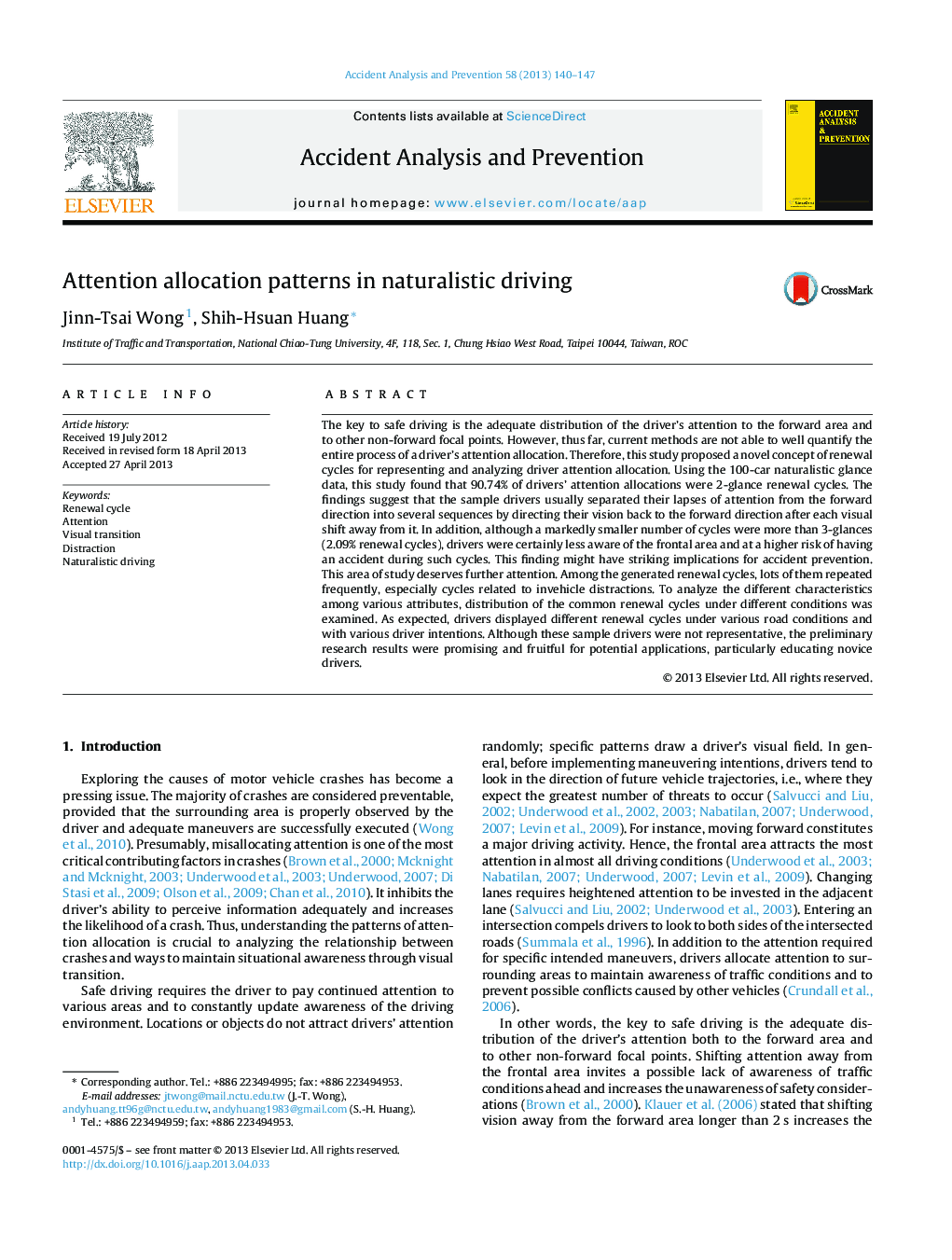| کد مقاله | کد نشریه | سال انتشار | مقاله انگلیسی | نسخه تمام متن |
|---|---|---|---|---|
| 6966180 | 1452939 | 2013 | 8 صفحه PDF | دانلود رایگان |
عنوان انگلیسی مقاله ISI
Attention allocation patterns in naturalistic driving
ترجمه فارسی عنوان
الگوهای تخصیص توجه در رانندگی طبیعی
دانلود مقاله + سفارش ترجمه
دانلود مقاله ISI انگلیسی
رایگان برای ایرانیان
کلمات کلیدی
چرخه تجدید، توجه انتقال ویژوال، حواس پرتی، رانندگی طبیعی
ترجمه چکیده
کلید رانندگی ایمن توزیع مناسب توجه راننده به ناحیه پیشرو و دیگر نقاط فوکوس غیر مستقیم است. با این حال، تا کنون، روش های فعلی قادر به اندازه گیری کل فرایند تخصیص توجه راننده نیستند. بنابراین، این مطالعه یک مفهوم جدید از چرخه تجدید برای ارائه و تجزیه و تحلیل تخصیص توجه راننده پیشنهاد کرد. با استفاده از داده های طبیعت گرایانه 100 خودرو، این مطالعه نشان می دهد که 90.74٪ تخصیص توجه رانندگان، چرخه تجدید دو چشم است. یافته ها حاکی از آن است که رانندگان نمونه اغلب توجه خود را از جهت رو به جلو به چندین توالی متمرکز کردند و دیدگاه خود را به سمت رو به جلو بعد از هر حرکت بصری از آن دور می کنند. علاوه بر این، اگر چه تعداد بسیار بیشتری از چرخه ها بیش از 3 بار مشاهده شده (2.09٪ دوره های تجدید)، رانندگان قطعا کمتر از منطقه پیشانی آگاه بودند و در معرض خطر بیشتری از تصادف در چنین دوره هایی بودند. این یافته ممکن است پیامدهای قابل توجهی برای پیشگیری از حوادث داشته باشد. این حوزه مطالعه سزاوار توجه بیشتر است. در میان چرخه های تجدید تولید، تعداد زیادی از آنها به طور مرتب تکرار می شوند، به ویژه در مورد چرخه های مربوط به حواس پرت های درون خودرو. برای تجزیه و تحلیل ویژگی های مختلف در میان ویژگی های مختلف، توزیع دوره های تجدید مشترک در شرایط مختلف مورد بررسی قرار گرفت. همانطور که انتظار می رفت، رانندگان چرخه های تجدید پذیری مختلف را در شرایط مختلف جاده و با نیازهای مختلف راننده نشان داد. اگرچه این رانندگان نمونه نماینده نبودند، نتایج تحقیقات اولیه برای برنامه های بالقوه و به ویژه آموزش رانندگان تازه کار امیدوار کننده و مفید بودند.
موضوعات مرتبط
مهندسی و علوم پایه
مهندسی شیمی
بهداشت و امنیت شیمی
چکیده انگلیسی
The key to safe driving is the adequate distribution of the driver's attention to the forward area and to other non-forward focal points. However, thus far, current methods are not able to well quantify the entire process of a driver's attention allocation. Therefore, this study proposed a novel concept of renewal cycles for representing and analyzing driver attention allocation. Using the 100-car naturalistic glance data, this study found that 90.74% of drivers' attention allocations were 2-glance renewal cycles. The findings suggest that the sample drivers usually separated their lapses of attention from the forward direction into several sequences by directing their vision back to the forward direction after each visual shift away from it. In addition, although a markedly smaller number of cycles were more than 3-glances (2.09% renewal cycles), drivers were certainly less aware of the frontal area and at a higher risk of having an accident during such cycles. This finding might have striking implications for accident prevention. This area of study deserves further attention. Among the generated renewal cycles, lots of them repeated frequently, especially cycles related to invehicle distractions. To analyze the different characteristics among various attributes, distribution of the common renewal cycles under different conditions was examined. As expected, drivers displayed different renewal cycles under various road conditions and with various driver intentions. Although these sample drivers were not representative, the preliminary research results were promising and fruitful for potential applications, particularly educating novice drivers.
ناشر
Database: Elsevier - ScienceDirect (ساینس دایرکت)
Journal: Accident Analysis & Prevention - Volume 58, September 2013, Pages 140-147
Journal: Accident Analysis & Prevention - Volume 58, September 2013, Pages 140-147
نویسندگان
Jinn-Tsai Wong, Shih-Hsuan Huang,
